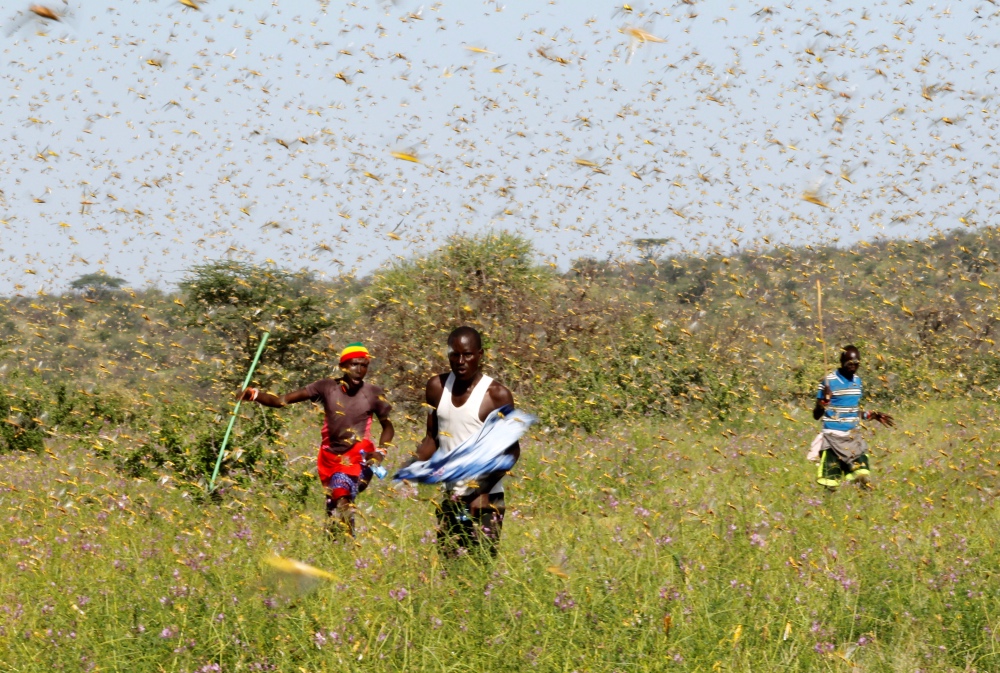Nairobi, Kenya
Thomson Reuters Foundation
Climate change may be powering the swarms of desert locusts that have invaded eastern Africa, ravaging crops, decimating pasture and deepening a hunger crisis, locust and climate experts said.
Hundreds of millions of the insects have swept over the Horn of Africa in the worst outbreak in a quarter of a century, says the United Nations.
By June, the fast-breeding locusts – already devouring huge swathes of Ethiopia, Kenya and Somalia – could grow by 500 times and move into Uganda and South Sudan.

Samburu men attempt to fend-off a swarm of desert locusts flying over a grazing land in Lemasulani village, Samburu County, Kenya, on 17th January. PICTURE: Reuters/Njeri Mwangi
The hungry swarms threaten to exacerbate food insecurity in a region where up to 25 million people are reeling from three consecutive years of droughts and floods, say aid agencies.
Keith Cressman, senior locust forecasting officer at the UN Food and Agriculture Organisation, said the swarms formed after cyclones dumped vast amounts of rain in the deserts of Oman – creating perfect breeding conditions.
“We know that cyclones are the originators of swarms – and in the past 10 years, there’s been an increase in the frequency of cyclones in the Indian Ocean,” said Cressman, adding that there were two cyclones in 2018 and eight in 2019.
“Normally there’s none, or maybe one. So this is very unusual. It’s difficult to attribute to climate change directly, but if this trend of increased frequency of cyclones in Indian Ocean continues, then certainly that’s going to translate to an increase in locust swarms in the Horn of Africa.”
The infestation from the Arabian peninsula has also hit countries such as India and Pakistan, with concern growing about new swarms forming in Eritrea, Saudi Arabia, Sudan and Yemen.
Climate scientist Roxy Koll Mathew from the Indian Institute of Tropical Meteorology in Pune said increased cyclones were caused by warmer seas, partly attributable to climate change.
“The West Indian Ocean, including the Arabian Sea, was warmer than usual during the last two seasons,” said Mathew.
“This is largely due to a phenomenon called Indian Ocean Dipole, and also due to the rising ocean temperatures associated with global warming.”
The swarms – one reportedly measuring 40 kilometres by 60 kilometres – have already devoured tens of thousands of hectares of crops, such as maize, sorghum and teff, and ravaged pasture for livestock.
If not contained, the potential for destruction is enormous – a locust swarm of a square kilometre is able to eat the same amount of food in one day as 35,000 people, says the FAO.
Authorities are responding with aerial spraying of pesticides, but experts say the scale of the infestation is beyond local capacity as desert locusts can travel up to 150 km in a day and multiply at terrifying speeds.
The UN has appealed to international donors for $US70 million in emergency aid to tackle the infestation and help communities to recover after losing crops and cattle.
Aid workers said increasingly erratic weather in east Africa – which saw a prolonged drought followed by heavy rains in late 2019 – was aggravating the infestation.
“This outbreak was clearly worsened by unusually heavy rains in the region and there is an interaction with the unusual cyclonic activity,” said Francesco Rigamonti, Oxfam’s regional humanitarian coordinator.
“It’s difficult to say that it is due to climate change – but there is an interaction between the two. What we do know is that we are having a lot of extreme events like droughts, floods and now locusts in the region, so we need to be prepared.”






